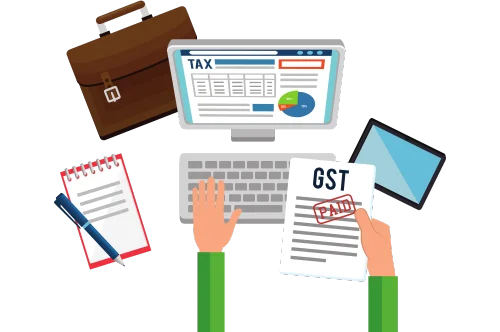E-Invoicing Under GST: Applicability, Format & FAQs
The introduction of e invoicing under GST has revolutionized how businesses manage and report their transactions. It brings standardization, transparency, and real-time tracking into the invoicing process. For Indian businesses, especially those growing rapidly, understanding the nuances of e-invoicing is essential for compliance and smoother operations.
In this blog, we’ll cover the applicability of e-invoicing, the prescribed format, and address frequently asked questions to help you navigate the system confidently.
What is E-Invoicing Under GST?
E invoicing under GST refers to the digital authentication of B2B invoices by the Goods and Services Tax Network (GSTN). Instead of generating invoices solely on an accounting software, businesses must now upload invoice details to the Invoice Registration Portal (IRP), which validates and assigns a unique Invoice Reference Number (IRN) and QR code.
This system was implemented to curb tax evasion, facilitate faster ITC claims, and streamline compliance under the GST regime.
Applicability of E Invoicing Under GST
Initially applicable to businesses with turnover above ₹500 crore, the scope of e invoicing under GST has been gradually extended:
From October 1, 2020: Businesses with turnover > ₹500 crore
From January 1, 2021: Turnover > ₹100 crore
From April 1, 2021: Turnover > ₹50 crore
From April 1, 2022: Turnover > ₹20 crore
From October 1, 2022: Turnover > ₹10 crore
From August 1, 2023: Turnover > ₹5 crore
Expected (Future Phase): Turnover > ₹1 crore (yet to be notified)
These thresholds are calculated based on aggregate turnover in any financial year since 2017-18.
Who is Exempt?
Certain entities are exempt from e invoicing under GST, even if their turnover exceeds the prescribed limits. These include:
Special Economic Zones (SEZ) units
Banks and financial institutions
Insurance companies
Goods Transport Agencies (GTA)
Passenger transportation services
Cinema ticket sellers
Format of E-Invoicing Under GST
The e invoicing under GST system follows a standardized schema (Format 1.1) notified by the GST Council. It ensures consistency and machine-readability across platforms.
Key Components of an E-Invoice
Invoice Reference Number (IRN): A unique 64-character hash generated using supplier GSTIN, invoice number, and financial year.
Supplier and Recipient GSTINs
Invoice Number and Date
Item-wise Details (HSN code, quantity, price, tax rates)
Taxable Value, CGST, SGST, IGST, and Total Invoice Value
QR Code: Contains IRN, GSTINs, invoice number/date, invoice value, and HSN code.
Digital Signature by IRP
The JSON format is uploaded to the IRP, which returns the IRN and signed QR code that must be printed on the final invoice.
How to Generate E-Invoice
Here’s a step-by-step breakdown of generating e invoicing under GST:
Prepare the Invoice: Use a compatible ERP/accounting software to create a B2B invoice in the prescribed format.
Upload to IRP: Send the JSON file to the Invoice Registration Portal.
IRP Validation: The IRP checks for duplicates and verifies the data.
Generate IRN and QR Code: On successful validation, the IRP issues an IRN and digitally signs the invoice.
Return to Supplier: The signed JSON, IRN, and QR code are returned to the supplier.
Final Invoice Issuance: The supplier prints or shares the final invoice with the embedded QR code and IRN.
Benefits of E Invoicing Under GST
Adopting e invoicing under GST offers several advantages:
Reduction in Data Entry Errors: Automated systems reduce manual intervention and minimize errors.
Real-Time Reporting: Transactions are reported in real-time to GSTN, ensuring better compliance.
Faster Input Tax Credit (ITC): Buyers get accurate data for claiming ITC without delays.
Standardization: Uniform invoice formats ensure better integration with other systems like e-way bill and GSTR filings.
Reduced Tax Evasion: Real-time validation deters fake invoicing and misreporting.
Common FAQs on E Invoicing Under GST
1. Is e-invoicing applicable to B2C transactions?
No. E invoicing under GST is currently mandated only for B2B and export invoices. B2C invoices are exempt.
2. Can I generate an e-invoice directly from my ERP?
Yes, provided your ERP is integrated with the IRP via API or middleware solutions. Many accounting software like Tally, Zoho, and Busy support this.
3. What happens if I issue an invoice without IRN?
An invoice issued without a valid IRN (where e-invoicing is applicable) is considered invalid under GST law, leading to penalties and loss of ITC for the buyer.
4. Is e-invoicing required for credit/debit notes?
Yes, if e-invoicing applies to your business, then debit and credit notes must also be reported to the IRP.
5. Do I need to generate an e-way bill separately?
Not always. When using e invoicing under GST, certain e-invoice portals can auto-populate e-way bill data, especially Part-A. However, you may still need to complete Part-B manually.
Challenges Faced by Businesses
While e invoicing under GST simplifies compliance in the long run, initial implementation can pose challenges:
System Upgradation: Small and medium businesses may need to invest in software upgrades.
Training Needs: Staff needs to be trained on the new workflow and reporting mechanism.
Internet Connectivity: Rural or remote businesses may struggle with reliable internet access.
Integration Complexities: ERP systems must align with the JSON schema and APIs provided by IRP.
These hurdles can be overcome with the help of GSPs (GST Suvidha Providers) and third-party API integrators.
Best Practices for E Invoicing Compliance
Evaluate Applicability Regularly: Monitor turnover each financial year to assess e-invoicing requirements.
Update ERP Systems: Ensure your software is compliant with the e-invoice schema.
Train Employees: Conduct training sessions to familiarize staff with the e-invoicing workflow.
Conduct Periodic Audits: Verify invoice data, IRNs, and QR codes for consistency.
Backup Data: Store validated invoices and signed JSON files safely for record-keeping.
Conclusion
With the phased implementation of e invoicing under GST, the government aims to create a robust, transparent, and efficient tax environment. For businesses, it’s not just a compliance mandate but an opportunity to streamline operations and reduce manual paperwork.
By staying updated on applicability, mastering the invoice format, and resolving common doubts, businesses can embrace e invoicing under GST with ease and confidence. Whether you’re already covered under the mandate or preparing for the next phase, early adaptation and proper planning can save time, reduce errors, and improve your GST compliance health.
Our GST Services

All E-commerce Tax services
E-commerce tax services help online sellers navigate GST registration, compliance, return filing, TCS management, tax planning, and audits, ensuring efficient tax management and legal compliance.

GST Filing
GST filing is the process of submitting tax returns to the government, detailing sales, purchases, and taxes paid or collected, ensuring compliance with GST laws.

GST Registration
GST registration is the process where businesses obtain a GSTIN from the government, allowing them to collect taxes, claim input tax credits, and comply with GST laws.






This is a great tip particularly to those new to the blogosphere.
Brief but very precise info… Many thanks for sharing
this one. A must read article!